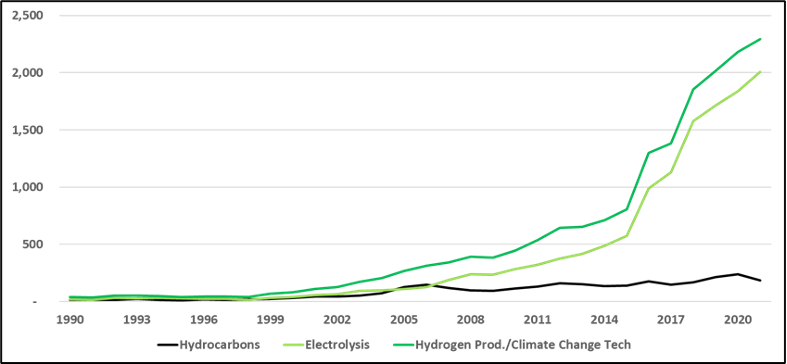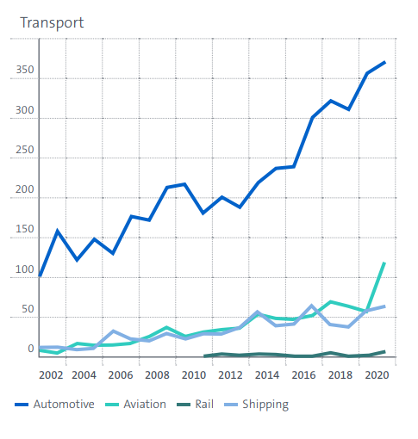Hydrogen has become one of the centerpieces of the world’s plans to transition to cleaner energy. But producing, storing and distributing hydrogen at a lower cost entails several challenges. New technologies are being developed to solve those challenges and, as the rate of innovation ramps up, so does the number of patents being filed for them.
Patent protection is essential for innovators to transform hydrogen research into market-ready inventions. Patents are also key to helping businesses raise capital, establish partnerships and ultimately scale up.
Innovations in green hydrogen production
Some types of hydrogen are cleaner than others. “Gray” hydrogen, for instance, is created using hydrocarbons such as oil or coal. “Blue” hydrogen uses natural gas in combination with advanced cleanup technologies. “Green” hydrogen uses electrolysis often from renewable power such as wind, solar or hydro sources.
As the world transitions to greener fuels, there has been a spike in patents corresponding to green hydrogen when compared to patents for hydrocarbon-based hydrogen.
Based on data from Techson IP Research, Figure 1 shows a substantial increase in U.S. patent filings related to green and blue hydrogen in the past 20 years compared to hydrocarbon-based generation.

According to the International Energy Agency (IEA), electrolysis corresponds to about 2% of global hydrogen production nowadays. But there has been a strong uptick in technology being developed to make electrolyzers more efficient, cheaper and scalable. This is translating into an increase in related patents globally.
According to a report from the European Patent Office (EPO) and the International Renewable Energy Agency, from 2005 to 2020, 10,894 international patent families (IPFs) related to water electrolysis were published worldwide, with an average annual increase of 18%.
Hydrogen’s storage and distribution challenges
Hydrogen is difficult to store and distribute over long distances. Thus, innovators are coming up with technologies to address this challenge.
Data from the EPO and IEA show that the number of published IPFs related to the storage of hydrogen in 2020 grew at a compound average rate of 13%. More recently, there has been a compound average growth of 13% in patents for liquid storage and vehicle refueling technologies, in the period 2011 to 2020, respectively. Innovation in pipeline networks and other related equipment, such as cryogenic heat pumps and valves, needed to distribute hydrogen has also generated a flurry of patent filings during the same period.
Innovation in end-use applications
Fuel cell cars are a promising end-use of hydrogen innovations. Since 2001, there have been significantly more IPFs for automotive applications of hydrogen than for aviation, rail and shipping, as can be seen in Figure 2, based on data from the EPO and IEA.

IPFs for aviation applications have grown at an average annual rate of 15% over the past decade, while IPFs for shipping applications have grown at 8%. However, only 33 IPFs were published for rail applications between 2010 and 2020, according to data from EPO and IEA.
Protecting hydrogen intellectual property
The growth in patents filed for technologies in hydrogen production, storage and distribution and end-use applications demonstrates that there is widespread awareness among innovators on the need to protect their intellectual property. Here are some considerations innovators should keep in mind when filing their patents.
Where to file?
The markets with key policy action supporting hydrogen markets are Europe, the U.S. and Asia-Pacific nations, so innovators in this space should consider filing in those countries (and in many cases, the key players already have).
Innovators should also consider filing in markets where competitors developing similar technologies are filing for patent protection.
Navigating IP rights
It is important to stay abreast of innovations being produced by market competitors. Even a company that has obtained patents on its own technology could be using practices or products that infringe upon other patents owned by others. This is especially true where, as with hydrogen, the market is rapidly expanding and cutting across multiple industrial sectors.
Companies and other players entering the hydrogen market for the first time or introducing a new product or service should consider whether they should perform a freedom-to-operate study. A freedom-to-operate study provides a more comprehensive look at the patent landscape surrounding products and services that may not be captured in a prior art or patentability search. Specifically, this study looks for any patent rights that may be infringed by the intended use of products or services.
Freedom-to-operate may depend on broad, foundational patents that may not invalidate a patent, but that would necessarily be infringed in a company’s process of practicing its own patent. For example, a company may have a patent on a new electrolysis catalyst, but that catalyst must be used in a reactor with particular material separating the cathode and anode. If another company owned a patent on that separator, use of the novel catalyst may require a license to the patent on the separator.
In the hydrogen space, freedom-to-operate may also depend on the use of patents covering technology that is tangential to a company’s patents or products. For example, a novel fuel cell for use in automobiles will almost certainly require the use of transportation and storage infrastructure before it could be commercially viable. Automobiles would need a steady supply of hydrogen accessible along all roads across the country, a means of storing enough hydrogen to power the fuel cell onboard the automobile itself, and a means of loading the hydrogen into the automobile. These interrelated areas are likely to have patents that may be infringed in the use of even a truly novel fuel cell technology. After studying the other patents implicated by their own patents and products, companies must decide how to approach licensing those other patents and how they might handle licensing their own patents to others. Freely taking and granting reasonable licenses may promote the overall growth of the industry. On the other hand, being more selective in granting and taking licenses may lead to greater profits for the company.
Even companies that are not providing the relevant technology but are instead sourcing it from others must keep these issues in mind, since the threat of patent infringement could still be an obstacle to the success of their operations and investments. In partnering with others or investing in hydrogen-related technologies, companies should thoroughly investigate whether their partners have the intellectual property rights needed to provide the technology they are offering without freedom-to-operate concerns.
Licensing programs
There does not currently appear to be any hydrogen market standards for licensing. However, using hydrogen as a reliable automobile fuel source may require substantial standardization of the industry. Cars would need reliable, standard connections and methods of obtaining hydrogen anywhere across the country. Thus, it may be advantageous for the industry to adopt licensing systems similar to what is seen in other industries to promote the stability of the industry as a whole.
One option widely used for standardized technologies in the telecom industry has been the guarantee of a fair, reasonable and non-discriminatory (FRAND) license to any patent deemed a “standards essential” patent. Thus, an automobile maker would be able to obtain FRAND licenses to use particular storage systems and hydrogen delivery systems that were deemed the “standard” for the industry. Another common option is the possibility of a patent pool. In a patent pool, many leading companies may reach an agreement to cross-license their patent portfolios to one another. In this manner, the companies that reach an agreement are able to use each other’s patents freely, while still maintaining their right to exclude those who are not willing to share their own technology.
Neither of these options, nor any other standard licensing program, has been implemented to date in the hydrogen industry. But given the possibility of these, or something similar, being adopted in the future, it is important to keep them in mind when making business decisions around licensing and patent protection. Companies should be diligent both in protecting their own innovations and monitoring the broader patent landscape in the hydrogen space to best position themselves to benefit from (and potentially influence the creation of) these types of programs as they emerge in the hydrogen industry.
The increase in patent filings signals that there will be more innovation, making it essential for those developing new hydrogen technologies to keep a close eye on an ever-changing market and ensure their innovations are fully protected.

 Baker Botts partner Liz Flannery and senior associate Thomas Carter work in the firm’s intellectual property department.
Baker Botts partner Liz Flannery and senior associate Thomas Carter work in the firm’s intellectual property department.
Recommended Reading
Enbridge Fortifies Dominant Role in Corpus Christi Crude Transport
2024-03-20 - Colin Gruending, Enbridge executive vice president and president for liquids pipelines told Hart Energy the company’s holdings in South Texas are akin to a “catcher’s mitt” for Permian and Haynesville production.
Enbridge Announces $500MM Investment in Gulf Coast Facilities
2024-03-06 - Enbridge’s 2024 budget will go primarily towards crude export and storage, advancing plans that see continued growth in power generated by natural gas.
Waha NatGas Prices Go Negative
2024-03-14 - An Enterprise Partners executive said conditions make for a strong LNG export market at an industry lunch on March 14.
Summit Midstream Launches Double E Pipeline Open Season
2024-04-02 - The Double E pipeline is set to deliver gas to the Waha Hub before the Matterhorn Express pipeline provides sorely needed takeaway capacity, an analyst said.
Kinder Morgan Sees Need for Another Permian NatGas Pipeline
2024-04-18 - Negative prices, tight capacity and upcoming demand are driving natural gas leaders at Kinder Morgan to think about more takeaway capacity.





